Chickenpox epidemiology and demographics: Difference between revisions
| Line 93: | Line 93: | ||
Image:Chickenpox Graph 2.jpg | Image:Chickenpox Graph 2.jpg | ||
Image:Chickenpox Graph 3.jpg | Image:Chickenpox Graph 3.jpg | ||
Image:VZV_-_Case Fatality Rate.jpg | |||
Image:VZV_-_Age 2.jpg | |||
Image: Chickenpox40.jpeg| Varicella cases and states reporting, United States, 1972-1996. <SMALL><SMALL>''[http://phil.cdc.gov/phil/home.asp From Public Health Image Library (PHIL).] ''<ref name=PHIL> {{Cite web | title = Public Health Image Library (PHIL) | url = http://phil.cdc.gov/phil/home.asp}}</ref></SMALL></SMALL> | Image: Chickenpox40.jpeg| Varicella cases and states reporting, United States, 1972-1996. <SMALL><SMALL>''[http://phil.cdc.gov/phil/home.asp From Public Health Image Library (PHIL).] ''<ref name=PHIL> {{Cite web | title = Public Health Image Library (PHIL) | url = http://phil.cdc.gov/phil/home.asp}}</ref></SMALL></SMALL> | ||
</gallery> | </gallery> | ||
==References== | ==References== | ||
Revision as of 16:21, 26 June 2017
Editor-In-Chief: C. Michael Gibson, M.S., M.D. [1] Associate Editor(s)-in-Chief:
|
Chickenpox Microchapters |
|
Diagnosis |
|---|
|
Treatment |
|
Case Studies |
|
Chickenpox epidemiology and demographics On the Web |
|
American Roentgen Ray Society Images of Chickenpox epidemiology and demographics |
|
Risk calculators and risk factors for Chickenpox epidemiology and demographics |
Overview
Varicella is an endemic disease spread mainly by the respiratory route. Cases are observed all through the year but most in the winter and early spring. In tropical regions, cases of varicella infection have been reported to be more commonly among adults than children.
Epidemiology and Demographics
Prevalence
- Since the chickenpox vaccine was developed in 1995, the major data of chickenpox in the environment is before 1995. In the prevaccine era, varicella was endemic in the United States, and virtually all persons acquired varicella by adulthood. As a result, the number of cases occurring annually was estimated to approximate the birth cohort, or approximately 4 million per year. Varicella was removed from the list of nationally notifiable conditions in 1981, but some states continued to report cases to CDC. The majority of cases (approximately 85%) occurred among children younger than 15 years of age.
- The highest age-specific incidence of varicella was among children 1–4 years of age, who accounted for 39% of all cases. This age distribution was probably a result of earlier exposure to VZV in preschool and child care settings. Children 5–9 years of age accounted for 38% of cases. Adults 20 years of age and older accounted for only 7% of cases (National Health Interview Survey data, 1990–1994). Data from three active varicella surveillance areas indicate that the incidence of varicella, as well as varicella-related hospitalizations, has decreased significantly since licensure of vaccine in 1995.
- In 2004, varicella vaccination coverage among children 19–35 months in two of the active surveillance areas was estimated to be 89% and 90%. Compared with 1995, varicella cases declined 83%–93% by 2004. Cases declined most among children aged 1–4 and 5–9 years, but a decline occurred in all age groups including infants and adults, indicating reduced transmission of the virus in 308 Varicella 21 these groups. The reduction of varicella cases is the result of the increasing use of varicella vaccine. Varicella vaccine coverage among 19–35-month-old children was estimated by the National Immunization Survey to be 90% in 2007.
- Despite high one-dose vaccination coverage and success of the vaccination program in reducing varicella morbidity and mortality, varicella surveillance indicates that the number of reported varicella cases appears to have plateaued. An increasing proportion of cases represent breakthrough infection (chickenpox occurring in a previously vaccinated person). In 2001–2005, outbreaks were reported in schools with high varicella vaccination coverage (96%–100%). These outbreaks had many similarities: all occurred in elementary schools; vaccine effectiveness was within the expected range (72%–85%); the highest attack rates occurred among the younger students; each outbreak lasted about 2 months; and persons with breakthrough infection transmitted the virus although the breakthrough disease was mild.Overall attack rates among vaccinated children were 11%–17%, with attack rates in some classrooms as high as 40%. These data indicate that even in settings where almost everyone was vaccinated and vaccine performed as expected, varicella outbreaks could not be prevented with the current one-dose vaccination policy.
- These observations led to the recommendation in 2006 for a second routine dose of varicella vaccine. Chickenpox used to be very common in the United States. In the early 1990s, an average of 4 million people got varicella, 10,500 to 13,000 were hospitalized (range, 8,000 to 18,000), and 100 to 150 died each year. In the 1990s, the highest rate of varicella was reported in preschool-aged children.
- Chickenpox vaccine became available in the United States in 1995. In 2014, 91% of children 19 to 35 months old in the United States had received one dose of varicella vaccine, varying from 83% to 95% by state. Among adolescents 13 to 17 years of age without a prior history of disease, 95% had received 1 dose of varicella vaccine, and 81% had received 2 doses of the vaccine. Eighty-five percent of adolescents had either a history of varicella disease or received 2 doses of varicella vaccine. Each year, more than 3.5 million cases of varicella, 9,000 hospitalizations, and 100 deaths are prevented by varicella vaccination in the United States.
Incidence
- Incidence is defined as the number of new cases per population in a given time period.
- The standard format to report the incidence is ___ per 100,000 individuals.
- When using numbers with decimal points, avoid reporting more than 1 number after the decimal point. For example, report a incidence as 10.1 instead of 10.09322. Many numbers after the decimal point may suggest a false sense of accuracy.
- You can pick one or more of the template sentences below for this section:
- Worldwide, the incidence of (insert disease state here) ranges from a low of _____ per 100,000 persons to a high of _____ per 100,000 persons with an average incidence of _____ per 100,000 persons.
- Worldwide, the incidence of (insert disease state here) is _____ per 100,000 persons.
- In developed countries, the incidence of (insert disease state here) ranges from a low of _____ per 100,000 persons to a high of _____ per 100,000 persons with an average incidence of _____ per 100,000 persons.
- In developed countries, the incidence of (insert disease state here) is _____ per 100,000 persons.
- In developing countries/ Africa, the incidence of (insert disease state here) ranges from a low of _____ per 100,000 persons to a high of _____ per 100,000 persons with an average incidence of _____ per 100,000 persons.
- In developing countries/ Africa, the incidence of (insert disease state here) is _____ per 100,000 persons.
- In ____ (insert year), the incidence of _______ (insert disease name) was estimated to be _______ (insert number) cases per 100,000 individuals worldwide.
Case Fatality Rate
- In 1990-1994, case fatality rate is 2-3/100,000 cases in the US/UK among which children's cases were 1/100,000 and adults cases were 20-25/100,000 cases. [1]
Age
- This section can describe the impact of the disease depending on the persons age, and the age-specific prevalence and incidence.
- The prevalence of ____ (insert disease state here) increases/decreases with age.
- _____ (insert acute disease) commonly affects _____ (insert age group).
- _____ (insert chronic disease) is usually first diagnosed among _____ (insert age group).
Gender
This section describe how prevalence of the disease varies by gender. When describing male to female ratios with decimal points, avoid reporting more than 1 number after the decimal point. For example, report a ratio as as 1.5 to 1 instead of 1.48294 to 1. Many numbers after the decimal point may suggest a false sense of accuracy. You can use either of the following template sentences:
- ______ (insert gender 1) are more commonly affected with ______ (insert disease name) than _____ (insert gender 2). The _____ (insert gender ratio e.g. male to female) ratio is approximately _____ (insert number > 1) to 1.
- The prevalence and incidence of (insert disease state here) does not vary by gender.
- Men and women are affected equally by (insert disease name here).
- (Insert disease state here) is more prevalent in men women.
- The prevalence of (insert disease state here) among men is ____ per 100,000, while it is _____ per 100,000 among women.
- The incidence of (insert disease state here) among men is ____ per 100,000, while it is _____ per 100,000 among women.
Race
This section describes how the disease differs based upon race. You can use the following template sentence for this section:
- The prevalence of _____ (insert disease) does not vary by race.
- (Insert disease state here) is more prevalent in the ____ (inser race) race and ____ (insert other race) races.
- There is no racial predilection for ____ (insert disease name)
- _____ (insert disease) usually affects individuals of the _____ (inser race) race. _____ (insert other race) individuals are less likely to develop ______ (disease name).
Developed Countries
- In this section you should describe the impact of the disease in developed countries.
- Incidence, prevalence, and geographical distribution or areas of interest can be mentioned, as well as the relevant impact the disease has on society.
Developing Countries
- In this section you should describe the impact of the disease in developing countries.
- Incidence, prevalence, and geographical distribution or areas of interest can be mentioned, as well as the relevant impact the disease has on society.
Age
- Varicella being one of the classical diseases of childhood, has a highest prevalence occurring between the age groups of 4 - 10 years old .
- It is highly communicable, with an attack rate of 90% in close contacts. Occurs mostly before adulthood but 10% of young adults remain susceptible. This pattern varies by regions, eg. in rural India, varicella is predominantly a disease of adults with the mean age of infection being 23.4 years which could be due to the interference by other respiratory viruses that the children are exposed to at an early age.[2]
- From generations, varicella has been a disease predominantly affecting the preschool and school-aged children. In tropical regions, the disease noticed among adults has the characteristics of the pocks being darker and the scars being more prominent than their younger counterparts.[2]
- In the U.S., 55% of chickenpox deaths are in the over-20 age group, even though they are a tiny fraction of the cases.
Gallery
-
-
-
-
-
-
Varicella cases and states reporting, United States, 1972-1996. From Public Health Image Library (PHIL). [3]
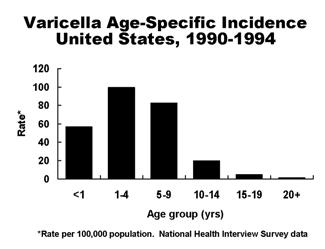
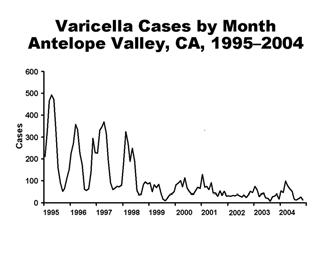
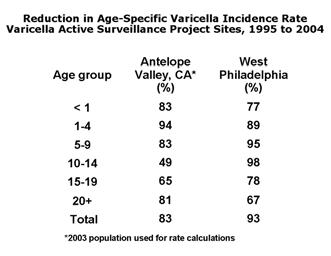
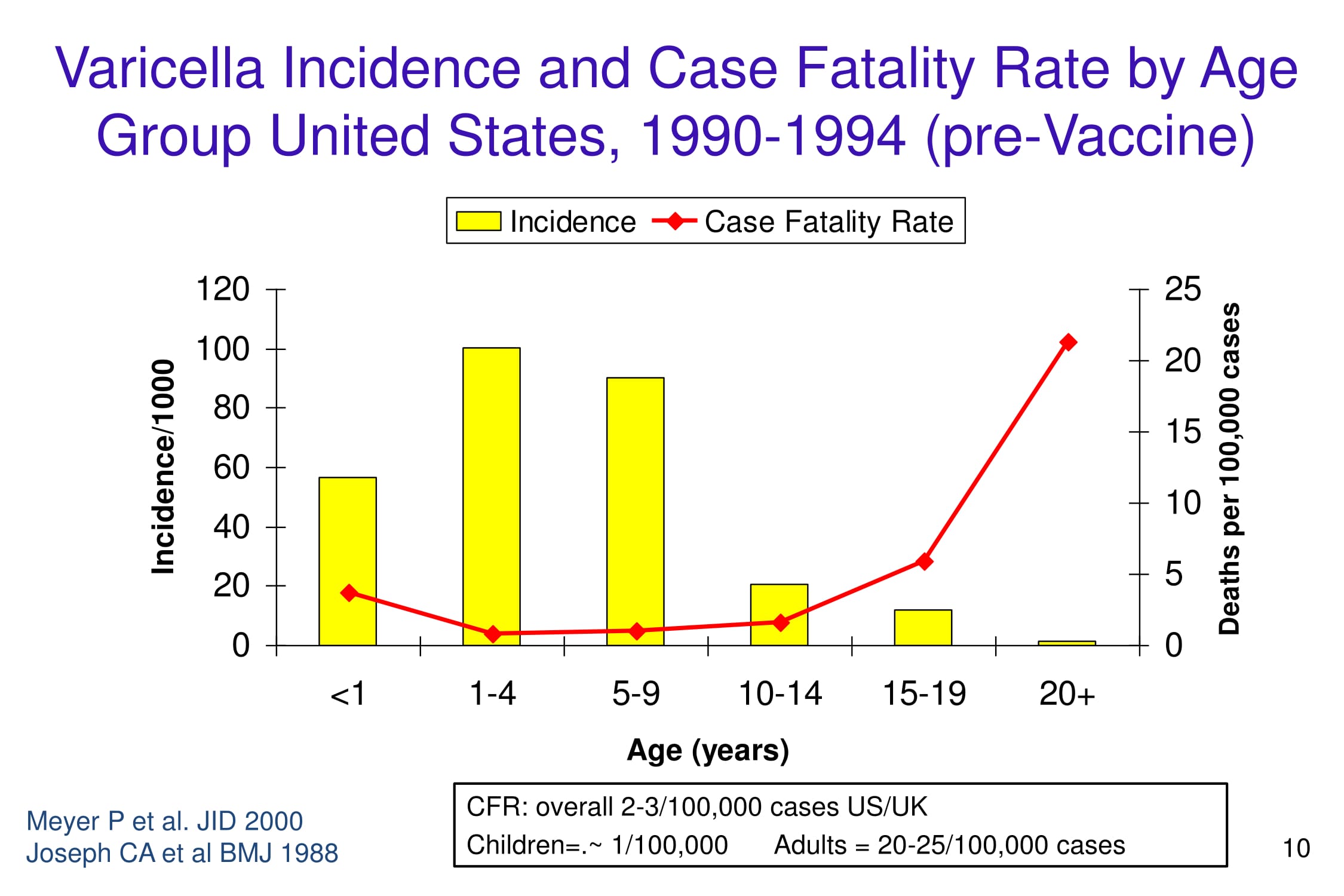
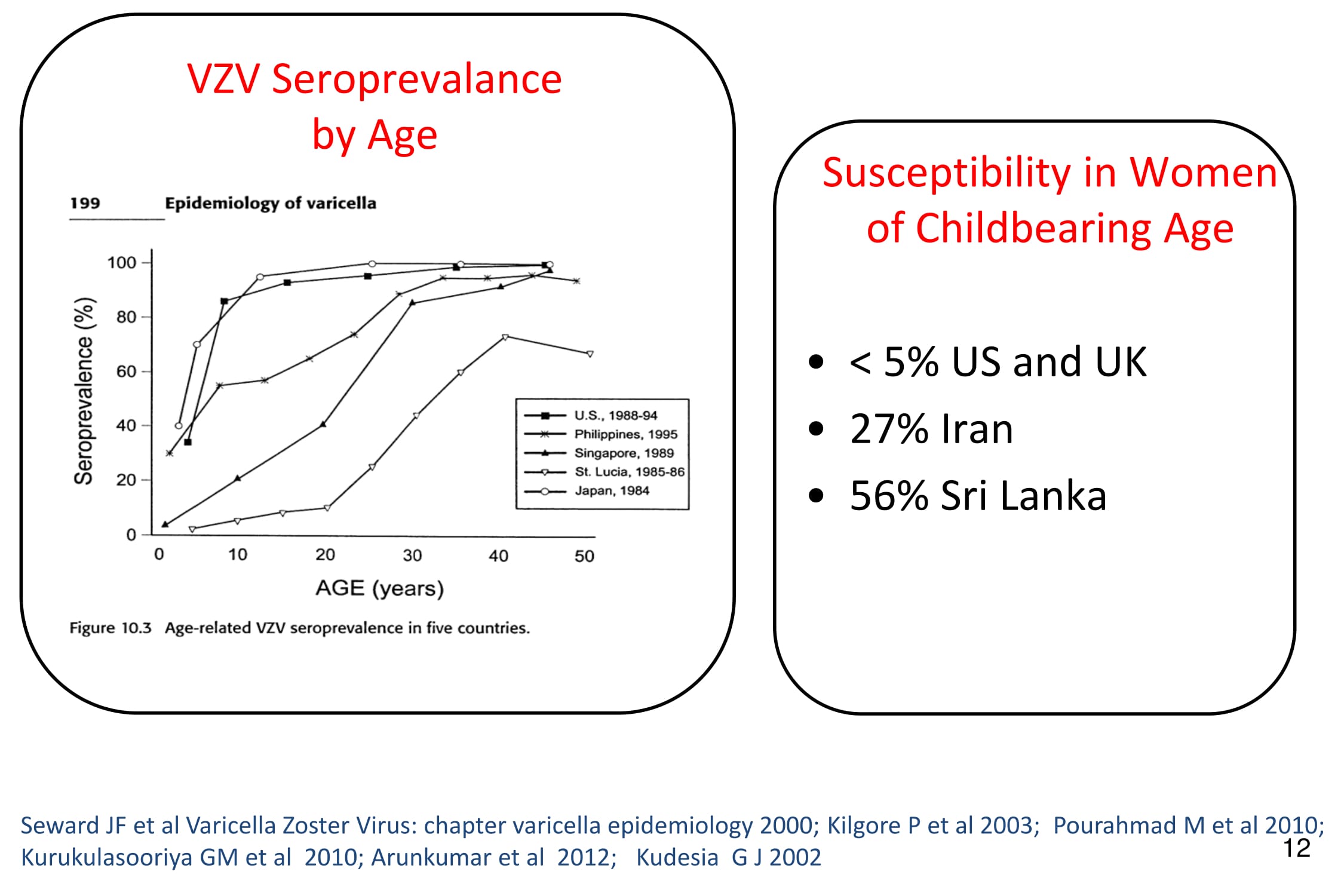
![Varicella cases and states reporting, United States, 1972-1996. From Public Health Image Library (PHIL). [3]](/images/2/26/Chickenpox40.jpeg)